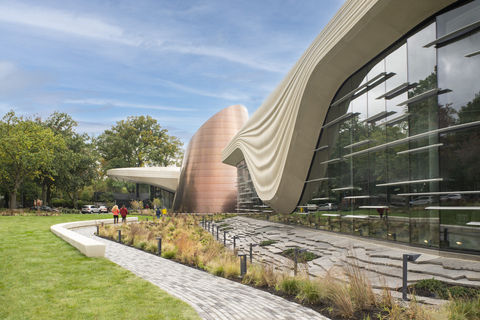CLEVELAND– The Cleveland Museum of Natural History, in partnership with DLR Group, has achieved the highest honor in sustainable building design, becoming the first museum in the United States to earn LEEDv4 BD+C NC Platinum certification. A prestigious status designated by the U.S. Green Building Council (USGBC), LEED, or Leadership for Energy and Environmental Design, is “the international standard for the design, construction and operation of high-performance structures”1 and LEED Platinum certification represents the pinnacle of energy-efficient building standards.
“As a leading cultural institution and a champion of a better future for both humans and the planet, the Museum’s new architecture reflects its mission,” said Sonia Winner, Museum President & CEO. “Through our partnership with DLR Group, our transformation aligns the exterior of our building with the exhibits within. It is architecture in service of our natural world.”
“With LEED Platinum certification, the Museum sets a new standard for natural history museums,” said DLR Group Principal and Global Architecture Leader Joshua Haney. “Using the past to inform our present to build a better future combined with a collaborative strategy, we produced a beautiful, energy-efficient building that elevates the human experience through design.”
The Cleveland Museum of Natural History’s $150 million transformation project is an unprecedented reinvention that aligns the Museum’s architecture with its mission of instilling a passion for nature and science in all learners. The project reimagines an existing 217,250 SF facility, located prominently within Cleveland’s cultural district, to more than 375,000 SF with more than 2 acres of outdoor visitor areas. The project includes a new Visitor Hall, lobby, and exhibit wing with completely new exhibits that break away from traditional museum compartmentalization by time period and scientific discipline. Instead, the Museum’s reconceptualized exhibits present an integrated storyline of planetary and biological processes that make these powerful forces tangible and relevant to contemporary life.
Working together and with consultant partners for landscape and civil design, DLR Group employed several passive and active sustainable design strategies to achieve LEED Platinum certification.
The Museum’s mission for the transformation project is to educate the community on how humans are connected to and impact the natural environment. In response, DLR Group designed a sustainability feature to be on display and spark curiosity for visitors by activating the primary façade of the new wing. During rain events, stormwater runoff is reduced by capturing rainfall from the roof via a gutter that daylights storm water through the GFRC cladding onto the alvar stone outcropping below. A rain garden with native plants reduces stormwater runoff by absorbing rainfall from the roof.


